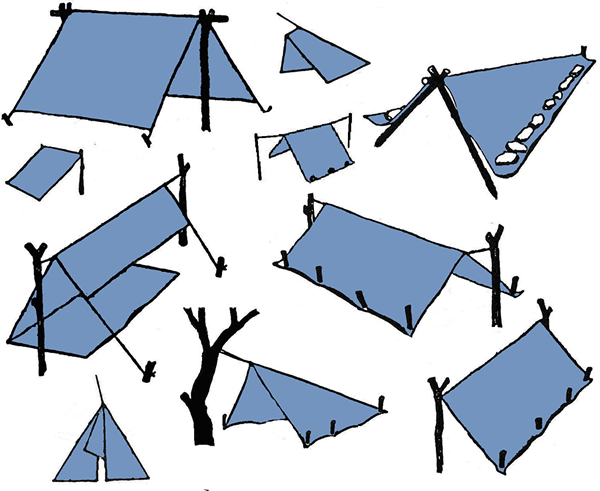Temporary Survival Shelter Configurations

In a survival situation, the first type of shelter you build is going to be temporary. The initial hope of the survivalist is to keep out of the elements long enough to be rescued. In the event rescue does not arrive, a more robust survival shelter for permanent use may need to be considered. With that in mind, the materials used to construct these temporary shelters will be things we can find in the wilderness, or things we have brought along with us.
Helpful Hints: Be mindful of the creatures living in nature. As you are gathering materials for a shelter, be aware of the fact that you may encounter all kinds of living things, some of which may be poisonous; this applies to plant, animal, and insect life.
Temporary Shelter Types:
• Rock Formations
• Trees
• Caves
• Lean-to
• A-frame
• Poncho Shelters
• Tarp Shelters
• Snow Trench
• Snow Cave
• Igloo
• Shallow Sand Pit
Rock Formations:
Overhanging rock formations are an excellent resource for immediate protection from the elements. Rock formations can also be used to improve the quality of heat by building a fire wall, or simply by warming rocks and stones and bringing them into the shelter and allowing them to disburse the heat they contain.
Prior to using an overhanging rock formation, take a few minutes to inspect it. Does it appear stable? Does it shift in the wind? Will it fall over, or is it susceptible to rock slides. You should also consider using a fire to smoke out any living creatures that might be using it as their shelter.
Trees:
Trees can be used to build shelters on, around, or beneath. The primary concern here is the condition of the tree itself. Living trees are preferred over dead trees. Trees with dense foliage are preferred over those with sparse foliage as they will provide better protection from precipitation. Do not build shelter near trees that are standing by themselves; these are lightning rods during thunderstorms.
Lean-to:
The best thing about debris shelters is that they are rather easy to construct, provided the materials are readily available. They are very easy to insulate with additional natural materials. They can be built by hand, with or without the use of traditional tools and accessories, such as a knife or rope.
The lean-to shelter is an excellent option for dry arid regions, rather than snow covered landscapes. These shelters can be constructed from natural materials, manmade materials, or a combination of both.
A-frame:
This is basically two lean-to shelters built opposite each other, yet using the same roof spine. These can also be made out of natural materials, manmade materials, or a combination of both.
Poncho & Tarp:
These manmade materials can be used to configure a large number of temporary survival shelters. There really is no limit to what you can construct with ponchos and tarps, provided you have the imagination to dream it up and put it together. Ponchos and tarps will make building a lean-to, or A-frame, a breeze to complete.
Snow Trenches, Caves, & Igloos:
Building a temporary shelter in the snow is a skill set that will definitely keep you alive. A snow trench is just what the name implies; it is a trench you dig in the snow and then cover with additional blocks of snow. A snow cave is something you dig out of an existing snow bank, and an igloo is more a permanent shelter than a temporary one. The purpose of these shelters is to get you out of the elements and keep you out of them until such a time as it is safe to start traveling again.
Shallow Sand Pit:
This is basically a desert shelter. It will be much easier to construct if you have a poncho or tarp. The process calls for digging a shallow trench/pit in the sand and covering it with a poncho or tarp to keep out of the sun, as well as to provide warmth in the evening. It is best built with a reversible mylar space blanket. This will allow you to place the reflective side up during the day, thereby keeping the pit cooler than the surrounding area, then flipping it reflective side down at night to retain body heat while you sleep.
Help Hint: Regardless of which shelter you choose to build, you will want to make it big enough to build a raised bedding platform inside. In a survival situation, you need to retain body heat, and sleeping in direct contact with the ground is the best way to lose body heat quickly.
More on StudySurvival.com
Free Survival Skills Training Resources at: Survivalist.com
This is some incredibly useful information! Thank you for sharing it with the community...
Great Info
Thanks for sharing